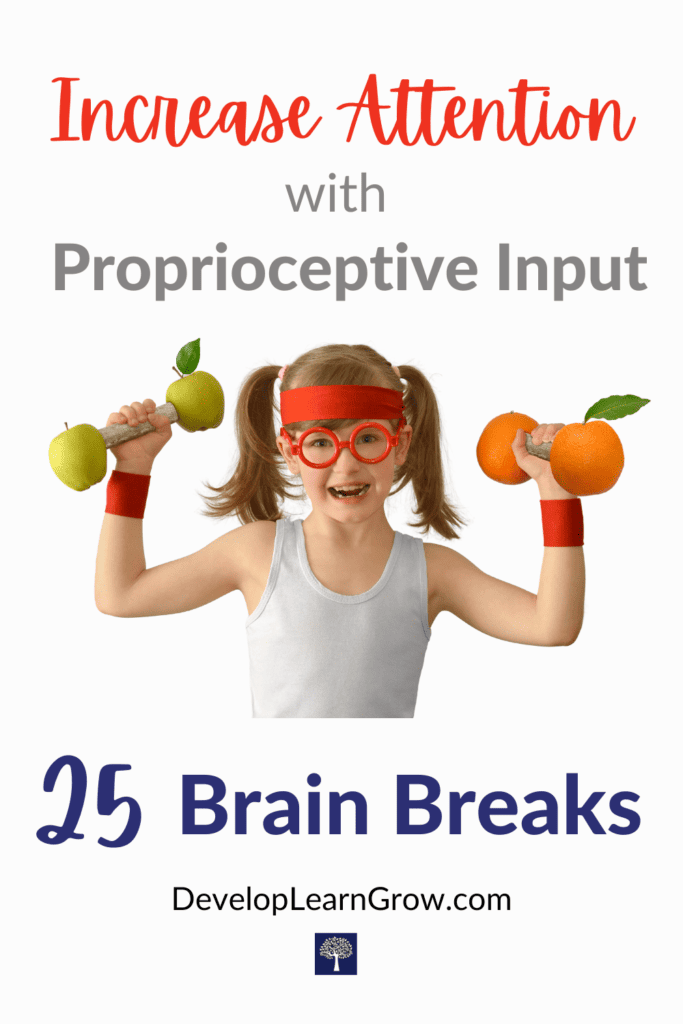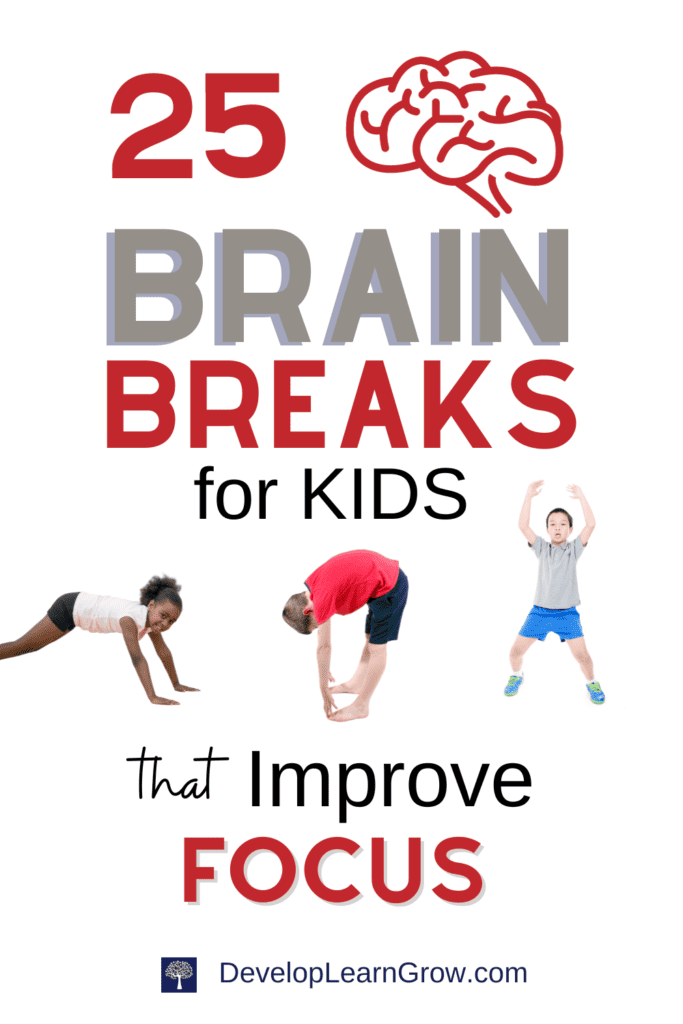Sensory brain breaks for kids are a great way to provide physical activity and a mental break for your whole class. The proprioceptive input provided during these fun brain breaks increase attention span. No equipment needed for these sensory breaks!
What are Proprioceptive Brain Breaks?
Brain breaks in general are short mental or movement breaks that are taken at regular intervals throughout the school day. These short breaks shift focus and re-set the brain for learning.
Kids with sensory processing disorder in need of a sensory diet are required to participate in daily brain breaks throughout the school year. However, as a school based occupational therapist I’m finding that ALL KIDS NEED sensory brain breaks.
Our learning standards have changed and we are expecting way too much academically from young children. The shift from play-based learning has caused more stress and anxiety in young children. Teachers are too stressed to add anything else but academics to their day. However, kids brain-body connection REQUIRES MOVEMENT for learning.
Younger kids and older children are NOT meant to sit all day and learn. They need physical movement in order to help increase attention span.
Physical activity gives ALL kids sensory input that helps with learning and behaving. The sensory systems are the foundation for learning (check out the Pyramid of Learning.)
Kids’ brains required a bottom up approach when learning. This means using the body from the feet up. Learning does not just happen in the brain.
Brain breaks using proprioceptive input for the muscles and joints gives powerful sensory information to the nervous system. Deep pressure, joint compression input and heavy work activities give the proprioceptive system strong input.
The power of proprioceptive activities are that they provide neural activity that calms and organizes a child’s nervous system, AND it increases alertness, attention and focus at the same time.
It’s my favorite type of input as an occupational therapist.

Why are Proprioceptive Brain Breaks for Kids Important?
Proprioceptive brain breaks for kids help calm and organize the nervous system and they increase attention and focus. They provide powerful input to a child’s nervous system, body and brain.
The various ways to provide the input through the muscles and joints helps kids with self-regulation, and it helps them refocus, think better, and behave better. Having fun with various proprioceptive activities also helps kids retain information. Using large muscle groups or a variety of muscles increases blood flow in the body and brain.
Additionally, the proprioceptive input for the body gives important motor feedback to the brain. This helps with body awareness and motor planning skills.
Some proprioceptive activities that I love using as an occupational therapist also work on core stability, shoulder stability, motor coordination, and hand strength.
For example, animal walks such as a crab walk, work on all of these skills. They are great sensory motor breaks.
A crab walk improves core strength and shoulder stability just by simply holding the position. The weight bearing input through the open palms stretches the hand muscles and makes them stronger. Finally, this motion requires added coordination, a great challenge for the brain.
Proprioceptive brain break activities are my favorite to use as an occupational therapist.
They are great for all toddlers, preschool children, and elementary students. I love that this input is calming & organizing AND alerting at the same time! Plus, it gives input to those kids with excess energy and proprioceptive sensory needs.
The saying in the OT world, “When all else fails, use proprioceptive input!” It has the best effect on kids’ nervous systems.
It helps all kids!
This input needs provided to the student’s nervous system throughout the school day throughout the school year in order to have a more optimal effect.
25 Proprioceptive Brain Breaks for Kids
The following list of proprioceptive brain breaks are quick and easy to add to your day. You don’t require any special sensory tools or equipment!
A free printable is available at the end of this blog post.
Use them before learning, in between lessons, and when transitioning. Or when you sense a break is needed!
They can be used and adapted for younger children and older kids.

1) Jumping jacks 10-20
Perform 10-20 jumping jacks. Change the speed of them – slow to fast, fast to slow, etc.
2) Seated chair lifts
While sitting, place hands near back of chair, lift body up and hold for 10-30 seconds. Repeat as needed.
3) High plank position
If space allows, kids stretch out on the floor in a push-up position. Arms are held straight with palms flat on the floor and toes on the floor. Hold for 10 seconds, and break for 10 if needed. Challenge kids to hold as long as possible (up to 30 seconds.)
When floor space is limited, modify by standing at desk and leaning into flat palms with straight arms, slightly and carefully lifting toes off the floor.
4) Yoga / adapted yoga positions
Try yoga positions that involve pushing through the arms such as table, downward dog, warrior, chair, etc.
5) Crab kicks
Have kids get into a crab walk position (stomach up toward the ceiling and hands and feet on the floor.) Hold the position and slowly kick each leg 10-20 times. If space allows, have kids crab walk in certain paths in the room.
6) Donkey kicks
Get into a bear walk position. Keep hands still and slowly kick each foot up in the air (behind and toward the ceiling.) Pause at the top. Perform 10-20 times.
7) Marching
Slowly march in place and bring knees up as high as possible. Alternate 10 strong marches and then 10 slow marches.
Have kids focus on controlling their leg movements so that they lower their leg and quietly place their foot back on the floor.
8) Jumping in place
Jump up and down 10-20 times. Encourage kids to land with soft feet.
9) Reverse table pose
Sit on the floor and lean back into straight arms / fingers pointing toward feet. Lift body up keeping hands and feet on the floor. Hold for 10-30 seconds.
10) Tip toe stretch
Stand on tip toes and stretch hands high above the head. Hold and squeeze for 20-30 seconds.
11) Arm circles
Use large movements: 10 forward circles / 10 backwards. Then try smaller faster circles: 10 forward, 10 backwards. Follow with floating arms straight up to the ceiling and slowly return them back to the sides.
12) Push-ups
Try push-ups on the floor. If space is not available, perform them on a desk or wall. Do 5-15 depending on location and ease of push-up.
13) Slow squats
Squat low to the floor without losing balance. Have fingertips tap the floor, 10-20 times.
14) Jog in place
Jog in place for 30-60 seconds.
15) Inchworm
Keep feet still, bend down and walk hands out on the floor as far as they’ll go (into a plank position.) Hold for a few seconds or do a push-up before walking hands back to the feet. Try this 5-10 times.
16) Hopping
Hop on right foot 10 times, hop on left foot 10 times.
17) Plank position
On the floor, if space allows, lie on the stomach. Push up onto the forearms / keep toes on the floor. Lift the body above the floor. (Toes and forearms should be the only body parts in contact with the floor.)
18) Dancing
Ask a student to lead a current popular viral dance or share one of your own! Kids love a fun dance break.
19) Sit-ups
Try sit-ups, crunches, or bicycles (elbow to opposite knee.)
20) Arm Scissors
Scissor arms straight out in front of the body (right hand over left, then left over right.) End with a “give yourself a hug” deep pressure squeeze!
21) Toe touches
Bend down and touch toes, pause at the bottom for a stretch through the legs. Perform 10-15 slowly.
22) Wall sits
Lean your back against a wall and slide down into a sitting position. If wall space is limited, hover above a chair. Hold for 5-35 seconds! Encourage kids to beat their own time.
23) Weight lifting
Hold largest workbook above head, move it slowly to each side (and slowly back to center in between.)
24) Plank jumping jacks
Get into a push-up position. Keep hands in one spot the entire time. Jump feet apart then together. Perform 5-15.
25) Reciprocal jumps
This is a bit of a tricky exercise! The starting position: right arm forward – left arm back – left leg forward – right leg back. Jump to switch leg position while also switching arm position.
Grab Your FREE Printable: Proprioceptive Brain Breaks for Kids
These 25 brain breaks for kids have been formulated into a one page free printable for your convenience.
As with any exercises, make sure students are not holding their breath as they perform them.
Make proprioceptive physical movement breaks a natural part of your school day. Make it part of your routine before learning, in between lessons, when transitioning, or for a much-needed break. Enjoy your free printable.
Additional Proprioceptive Brain Breaks for Kids
The list of 25 proprioceptive breaks in this post gives you a basic starting point of physical movement activities. They are great for ALL kids but especially helpful for kids with ADHD and kids with sensory needs. Physical exercise is a great way to give proprioceptive input.
A simple way to also give input to the muscles and joints is by encouraging Floor Work and Vertical Work. Simply changing a child’s work position is a great way to give proprioceptive input AND to work on core stability.
In addition, Core Exercises for Kids stimulate the proprioceptive system and also help improve core strength (which is lacking in so many kids!)
There are several sensory tools that provide Calming Deep Pressure Input that Increase Focus. This post shares specific weighted tools and more deep pressure exercises and activities that increase focus in kids.
You can use additional postural supports in your learning environment by using Flexible Seating options. These are great for posture, core stability and attention (if the right flexible seating choices are made.)
For your students with sensory processing disorder, ADHD, or excess energy, they may need many of the strategies listed in this section. Additionally, you can give them heavy work tasks such as stacking chairs, holding doors, carrying heavier objects, pushing furniture, or pulling bins or furniture for clean-up.
They may also need additional movement breaks listed in the next two sections.
Do Your Students Need a Brain Break CHALLENGE?
This classroom exercise program offers 8 weeks of exercises. Each week has a list of several, quick brain breaks that focus on sensory, sensory motor and fine motor development.
The goal of the program is to practice the same sequence of exercises every day for one week. This gives kids a chance to work on improving the skills, rather than throwing random brain break exercises at them every day.
Use these specific occupational therapy exercises to improve:
Attention… focus… core stability… crossing midline… sensory processing… visual development… & more… Click for more info!
Check out These Related Posts with More Sensory Breaks for Kids
Brain breaks are a fun way to improve memory and learning in kids. Proprioceptive and movement brain breaks enhance learning using a bottom up approach. Kids need input through the body in order for neural activity to increase in the brain for learning.
Proprioceptive brain breaks are a great way to increase attention and organize the nervous system, but there are several other fun brain break ideas that benefit kids during the school day.
You need a variety of options to choose from. The brain breaks listed below stimulate other sensory systems to help with self-regulation in kids.
- Best Educational Brain Break Exercises – FREE PDF Printable –The FREE printable contains an exercise sequence that stimulates the proprioceptive and vestibular systems. One of the exercises listed in the series activates the left, right, top, bottom and front, back areas of the brain! One cool motion that stimulates so many parts of the brain!
- Movement Activities to Enhance Learning — These movement brain breaks stimulate the vestibular system to wake up kids’ brains and increase focus! They are great to throw into your daily routines during the school day. Kids need proprioceptive input and MOVEMENT!!
- Wake the Brain With Proven Oral Sensory Activities — The mouth is an important area of the body that provides powerful sensory input to help kids (and adults!) focus. There are simple snacks, strategies and activities that provide oral sensory input for those kids who tend to need it during the day.
- Glitter Art – A Skill Building Craft with a Twist! — This post shares a cool oral sensory calming craft activity for kids. Sometimes the best breaks are mindful brain breaks. And what better way than to use a craft AND add calming oral sensory component!
- 48 Quick and Easy Alerting Sensory Strategies to Get Kids’ Attention — If your kiddos are sluggish, and you need to grab their attention, here you go! This post shares strategies from the different sensory systems that increase alertness in kids.




0 Comments